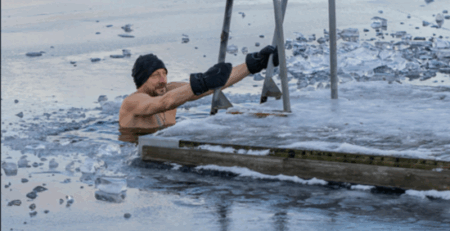Honestly, getting injured is the most frustrating part of sports. Whether it’s a rolled ankle, a pulled muscle, or just general inflammation from overtraining, it sidelines you and throws off your entire game.
While rest, rehab, and proper nutrition are non-negotiable, one of the most powerful recovery tools isn’t found in a pill bottle. It’s found in a tub of cold water. Cold plunging isn’t just about numbing the pain; it’s about actively tapping into your body’s natural healing systems to accelerate recovery and get you back in action faster.
Table of Contents
The First Step: Controlling Inflammation After Injury
The immediate goal after any acute sports injury is to control the damage. Your body’s initial inflammatory response, while necessary, can often be a little too enthusiastic. This is where controlled cold water immersion comes in. It’s a targeted strategy to manage that response without shutting it down completely.
The first thing that happens when you get into an ice bath tub is intense vasoconstriction. This is just a fancy term for your blood vessels tightening up. For a fresh injury, this is crucial. It acts like a natural tourniquet, reducing blood flow to the injured area and limiting the amount of swelling and bleeding into the tissues. Less swelling means less pressure on the surrounding nerves, which directly translates to less pain. It also means the area won’t get as stiff, which helps maintain a better range of motion early on.
Research published in the Journal of Athletic Training supports this effect, noting that cryotherapy can significantly reduce swelling and pain in the acute stages of sports injuries. The scientific consensus proves that early cold therapy helps stabilize tissue damage and control inflammation.
Protecting Your Cells from Further Damage
But it’s not just about the initial squeeze. That inflammation we talked about is driven by metabolic activity. The injured cells are in a state of chaos, releasing chemicals and consuming oxygen at a high rate, which can lead to secondary tissue damage. Cold plunging helps slow this metabolic storm in the injured tissue.
By reducing the tissue’s temperature, a cold plunge decreases its demand for oxygen and energy, protecting surrounding cells from “secondary damage.” Think of it as hitting the pause button on the injury site—giving your body a chance to regroup before healing ramps up.
Supporting Rehab and Return to Training
How Cold Plunges Help Manage Pain
Let’s be honest: sports injuries hurt. Managing that pain effectively is key to getting back into gentle movement and early rehab. A cold plunge dulls pain through two main mechanisms:
- First, the cold slows down the conduction velocity of your nerve fibers. Simply put, the nerves carrying the “ouch” signals to your brain can’t fire as quickly or as often.
- Second, the intense cold stimulus triggers the gate control theory of pain. The overwhelming “COLD!” signal your skin sends to your spinal cord effectively blocks the weaker pain signals from the deeper injury, preventing them from registering in your brain.
Together, these effects make cold plunging one of the most natural and effective ways to reduce pain without relying heavily on medication.
Easing Back Into Training
The role of cold plunging doesn’t end after the first few days. Cold plunging can be a game-changer for managing the inflammation that comes with returning to training. When you’re coming back from an injury, the affected area is often more prone to getting swollen and sore after exercise. A post-workout cold plunge can help manage this exercise-induced inflammation, preventing a setback. It’s not about completely blocking the healing inflammation but about keeping it from going overboard and causing more pain and stiffness than is necessary.
A study in the European Journal of Applied Physiology found that cold water immersion after exercise can attenuate the inflammatory response, which is particularly useful during a careful return to sport.
Relaxing Protective Muscle Tension
It’s also important to address the muscle guarding that happens around an injured joint. When you have, say, a sore knee, your quad and hamstring muscles might tense up to protect it. This involuntary spasm can actually hinder recovery by altering your movement patterns. The cold from an ice bath has an antispasmodic effect, helping to relax these protective muscles and reduce spasm, which allows for better blood flow and more comfortable movement during rehabilitation exercises.
Timing Your Cold Plunge Strategy
Using a cold plunge for a sports injury recovery isn’t a one-size-fits-all approach. In the first 24-72 hours, it’s all about damage control: reducing swelling, bleeding, and pain. As you move into the rehab phase, it becomes a tool for managing post-therapy inflammation and breaking cycles of muscle tension. It’s a way to actively participate in your recovery, using your body’s own cold-induced reflexes to create a better environment for healing.
Conclusion
Cold plunging is more than just a tough-guy ritual—it’s a scientifically supported recovery method that works with your body’s natural systems. From controlling inflammation to reducing pain and promoting muscle relaxation, cold water immersion can help you recover faster and return to your sport stronger and more resilient.
When used wisely, the cold becomes your ally, not just for healing an injury, but for building a mindset that thrives under pressure, adapts to discomfort, and emerges tougher every time.












Leave a Reply